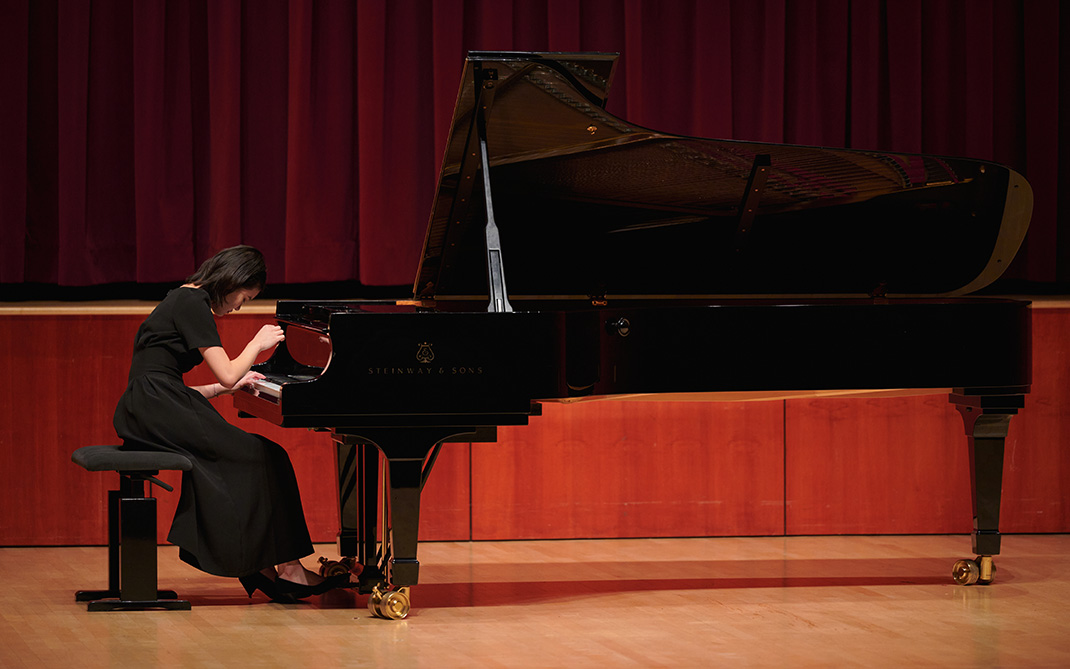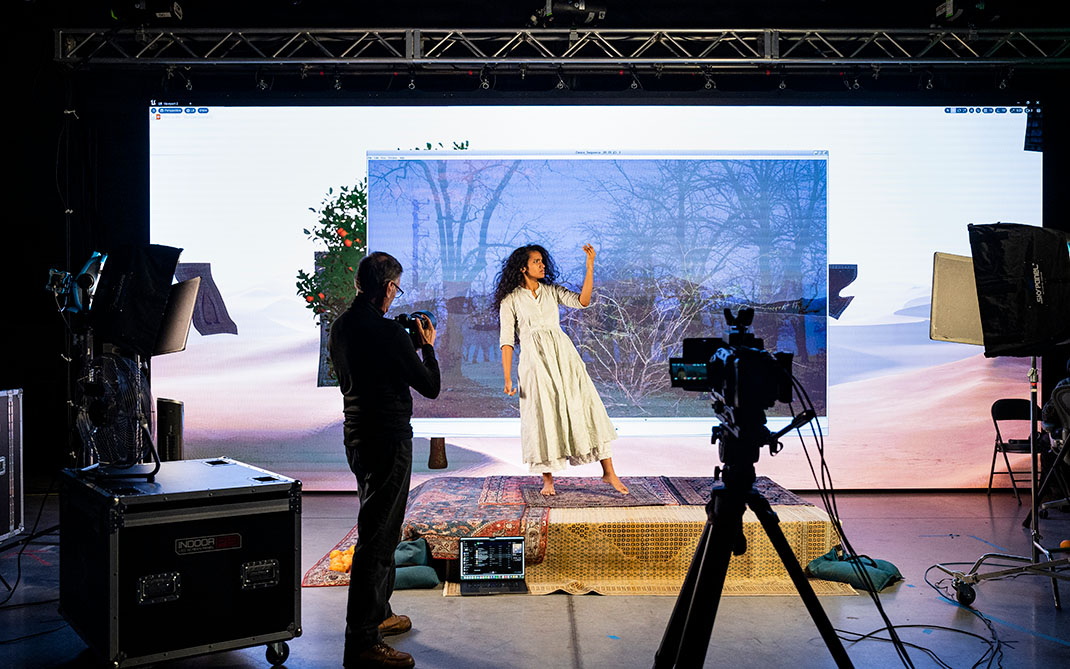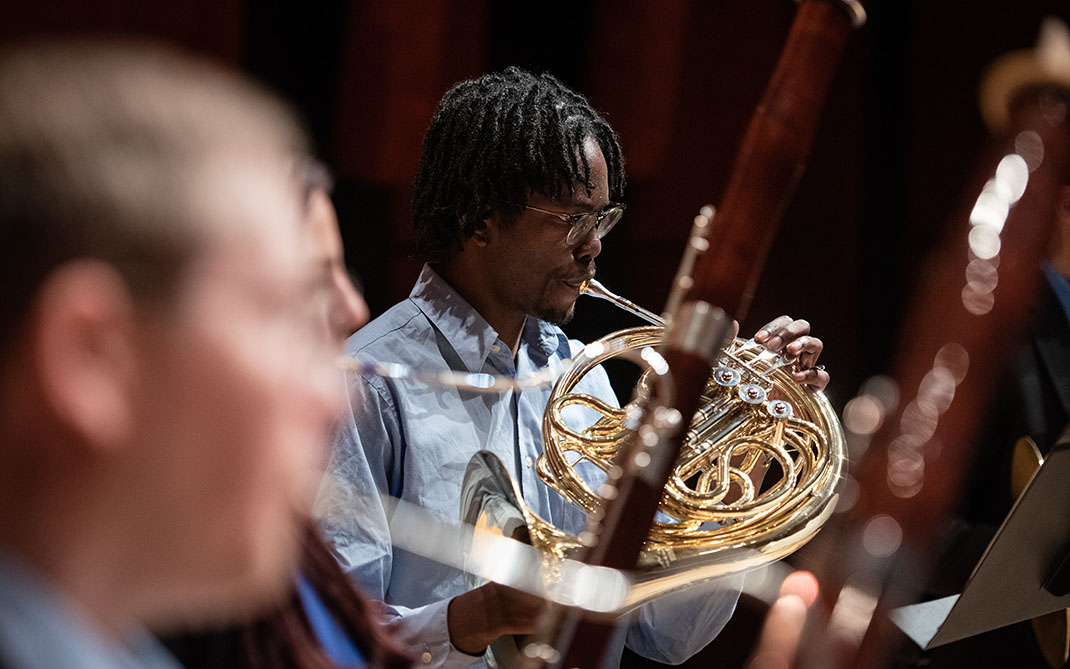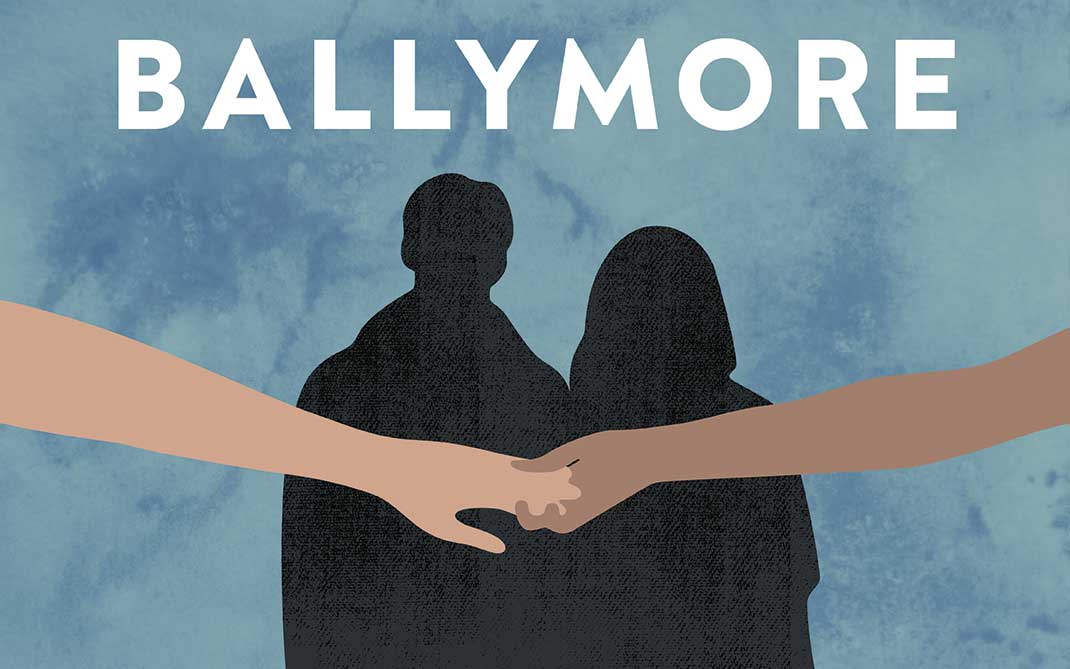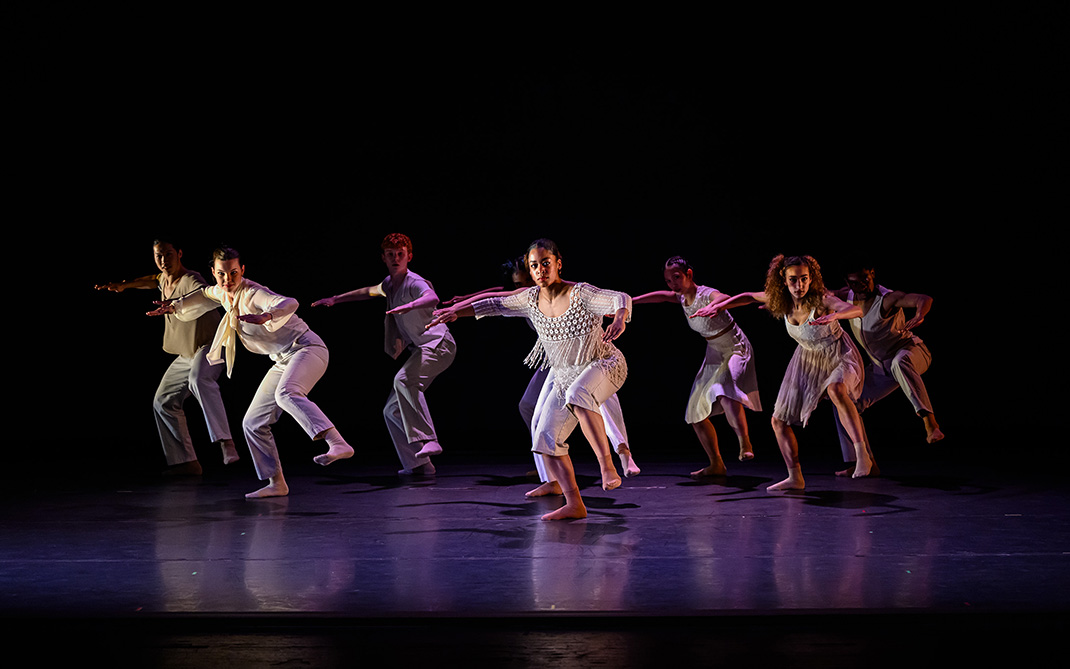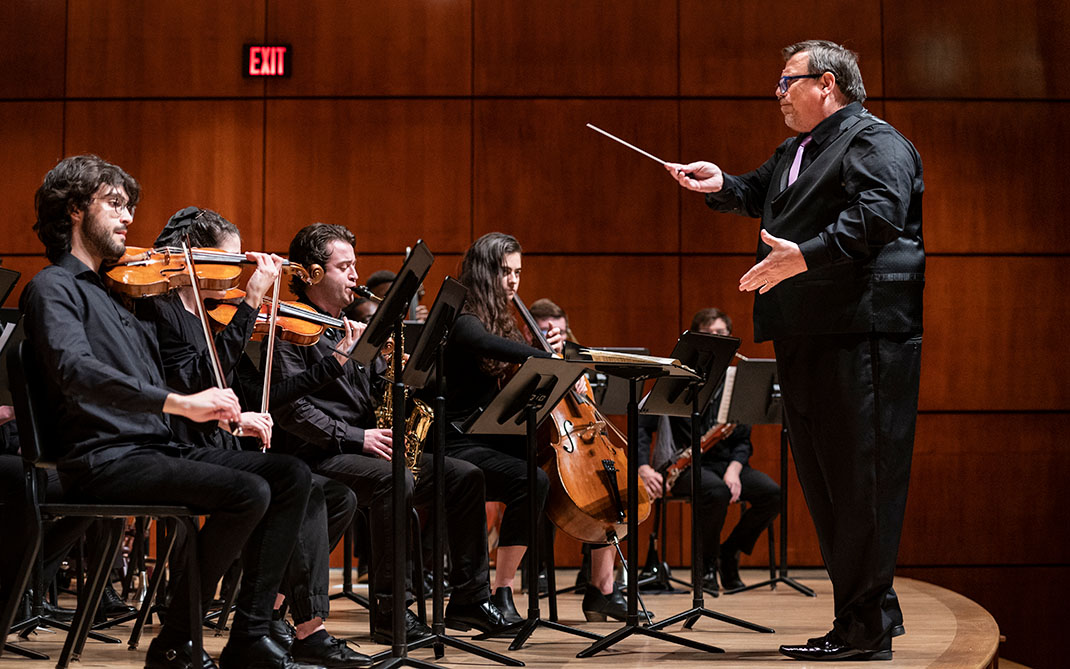Artist as Leader: Tony Woodcock
Tony Woodcock, currently the Interim Dean at the School of Music at UNCSA, is a veteran arts manager, having led as CEO several major orchestras in both the States and the UK. A passionate educator, he was President of the renowned New England Conservatory, where he launched two programs designed to nurture and encourage artist leaders: the Sistema Fellowship and the Entrepreneurial Musicianship program. In 2015 he founded Scolopax Arts, a consulting firm that continues to advise arts and educational organizations all over the world.
When he is not working in Winston-Salem, he is most likely in Spain, where he is a visiting professor in social entrepreneurship at Berklee School of Music’s Valencia campus and visiting professor in musical entrepreneurship at Escuela de Musica Reina Sofía in Madrid.
In this conversation, Corey and Tony discuss artists’ responsibilities not only to their craft but also to their communities and how by including leadership training in their curricula, arts programs could benefit not only their students’ careers but also the vibrancy of communities around the world.
Choose a question below to begin exploring the interview:
- How has your background informed your leadership style?
- How has your world-view and fascination for travel influenced you as a leader?
- How as your training as an artist shown up in your work as a leader?
- Did you stop performing when you transitioned into management?
- What roles do reflection and experimentation play right now in your career?
- Do you see leaders who are not artists having the same capacity to reflect or experiment or revise?
- How does listening make us able to lead better?
- What’s been the hardest part for you of being a leader?
- What do you think needs to change to encourage more artists to lead?
- What advice would you have liked to receive when you were starting out as an artist leader?
- Epilogue
Corey Madden: Tell me a little bit about how your background and upbringing might have formed your leadership style.
Tony Woodcock: That’s a really fascinating question. I think all it has to do with being an Army brat. When I was very little, my father was a career officer in the British Army. He took us all over the world. I was born in the Middle East, we went off to the Far East (I was in Singapore), and I was schooled in those places. That very early experience gave me a taste for a multicultural life and experience, which, when I think about it and dwell upon it, has informed a lot of who I am today. That sense of cultural curiosity, which has always been with me. I’m always fascinated by whatever country I go to.
It’s also created a very deep ambition to travel a lot. I’ve traveled to I don’t know how many countries, but if I just take America, I’ve been to something like 44 states.
Corey: Wow!
Tony: Not collecting them, so to speak, but just interested to see what they were like and what they would offer.
Corey: How does that world-view and that fascination for travel impact you as a leader?
Tony: I think it has helped me with the concept of diversity. I often ask students this question, “What is diversity?” Then they sort of freeze a little bit, and I say: “OK, let’s approach it differently. What isn’t diversity? Let’s say you have an important global issue, and you get into the room 10 attorneys — all aged 35, all men — is that diversity? Is that the best way of resolving that issue?” Everyone says no. “Same issue. What happens if you get 10 women attorneys, all aged 35, in the room? Would that be diversity as well?” No, it wouldn’t. That isn’t diversity. What could be diversity? What is it that we’re celebrating when we actually create a diversity?
Corey: How did you train as an artist, and how has that training continued to show up in your work as a leader?
Tony: I trained as a violinist. I was a very serious violinist and eventually a viola player as well. I took a degree in music in the UK, and I went out to earn a living as a performer and was moderately successful in doing that. Then the opportunity arose to move into music management. I was very excited to do that because I got to work with some of the greatest artists in the world and I was young and starry-eyed. All of a sudden there I was looking after people like Arthur Rubinstein and David Oistrakh. It was very heady.
It was my training in music, though, that was the inspiration for everything that I wanted to do ... when I was with an artist, when I was working with music directors, I was working with them not as the objective business manager of the organization; I was there as an artist with them, understanding their concerns, understanding their needs, and understanding and helping to shape their vision as well.
It was my training in music, though, that was the inspiration for everything that I wanted to do. When I was working with orchestras and doing program-planning, when I was with an artist, when I was working with music directors, I was working with them not as the objective business manager of the organization; I was there as an artist with them, understanding their concerns, understanding their needs, and understanding and helping to shape their vision as well.
I ran orchestras for 25 years or more, both in the States and the UK, and I had an empathy with musicians. They understood that I had a difficult job to do and that a lot of that job was to do with business, but they also knew that I understood their difficulties as well: the difficulties of the repertoire that might be chosen, the difficulties of travel that might be there, the difficulties that they might have with their instruments, what they needed in their private and personal lives, whatever it might have been. I feel that if I had not had that start as a violinist, as an artist moving into the management side, I would have treated all of those people and all of those situations very differently and probably not appropriately.
Corey: I’m hearing you speak of empathy. What in your training taught you to be an empathetic person? Or did that come from someplace else?
Tony: The image I would give you in response to that is chamber music. Not orchestra music where you have a lot of people and you have one leader, but chamber music where you are actually sharing and there’s consensus-building and there’s a tremendous amount of empathy and support and joint vision-making and discussion and that wonderful communication that happens without words. It’s just there. When I’ve built teams, I’ve I tried to build a team in a chamber-music way. Does that make sense?
Corey: Absolutely. What are you listening for? What are you looking for? How does your sensibility help you do that?
Tony: Obviously you’re looking for the basics. You’re looking for skills, you’re looking for people who are kindred spirits, but not necessarily. You’re not getting in the room five people who are all like you, because that’s chaos, isn’t it? Five people who all have the same radical ideas, all want to charge the hill, you don’t want that. You want a diverse balance of world perspectives and experience that listen to one another, help to shape one another so that what you come up with as solutions to problems or new initiatives is something that is brilliantly colored by this diverse opinion and this diverse skill set.
Corey: It’s such a great metaphor, isn’t it, that diversity is really like what we appreciate in musical instrumentation.
Tony: When I was at NEC [New England Conservatory], I often used to go classes just to hear the approaches that they took. I remember Paul Katz, a cellist, saying to students, “Yeah, you know, technically it’s sounding great. All we need to do now is to look at some tone colors, really imagine those colors so that they glow and communicate and engage an audience and then consider the voicing of it and the phrasing of it. And then we’ve got something musical!”
You obviously need to have some technical expertise, but if it's technical expertise without humanity, then what you’ve got is an empty vessel that will not persuade anyone or not provide anyone with the riches that are in our culture.
You obviously need to have some technical expertise, but if it's technical expertise without humanity, then what you’ve got is an empty vessel that will not persuade anyone or not provide anyone with the riches that are in our culture.
If you’re an artist or if you’re running an orchestra, you’ve got to think of this in terms of, “What is it that we are providing? How important is it to our culture? How important is the engagement with community? How important is the engagement with the dispossessed or the underprivileged?” It’s not the technical perfection onstage; it’s the application of the power of the music and how that can be given to as many people and effect, transform, beautify and improve the lives of all of those people.
Corey: Artistry isn’t artistry unless it has an intention that’s deep and humane. One thing we’ve noticed at the Kenan Institute is the gap between the professional arts and everyone else. There are so many artists and leaders in the community who want to be trained but might not be able to, in a sense, audition into the school.
Tony: Yes, I think you’re absolutely right. For me, the problems that we face are the technocratic view and overspecialization, which is endemic in our world now. It’s happened certainly in music (I can’t speak for other art forms.) I’ll give you a specific. In an orchestra, let’s say you are auditioning for a principal piccolo. So all these fabulous piccolo players come, and somebody stunning gets engaged. And that’s what they do. They play the piccolo. Sometimes they play third flute, but they’re there as the specialist piccolo player. They’re not there as a package of fabulous talent that can contribute onstage, off-stage, in the community, helping fund-raising, helping with the community-engagement program. They’re there as the specialist piccolo player.
Now that is characteristic of our age. It’s not characteristic of the arts and history. I think we almost need to go backwards in time to redefine the role of an artist. Because in Beethoven’s time, Haydn’s, Mozart’s, maybe Brahm’s even, if you were a musician, you were many, many things. Maybe your playing wasn’t as excellent as we enjoy now, but you were contributing. If you were a violinist, you were probably a viola player; you probably had one or two other instruments that you could dabble in; you taught; you composed; you arranged; you were in the community. You were a community figure. Those things are an institution. An orchestra never seems to harness that.
Often a musician’s main living could be in an institution, but the things that really interest them are outside the institution where their focus is. It seems a shame. If you think about harnessing all of those wonderful attributes into one single beautiful initiative in the community, just think of what you could change and the contribution you could make!
Corey: Did you stop performing when you transitioned into management?
Tony: Oh, no. No, I think this is one of those things that a lot of young musicians have got to understand. I’ll cite a very good colleague of mine, Rachel Roberts, who is at NEC. I appointed her as the head of a brand-new initiative on musical entrepreneurship many years ago. She was the star flute player at the Eastman School, I mean destined for a top position as a flute player. She played, and she decided that that wasn’t enough for her life. And she went into management. Does that mean that she stopped being a musician? No. What she did was she kept her playing going.
In fact, she wrote to me about two days ago, and she said, “Oh I just gave a recital with a good friend of mine at Tufts University.” I know that the repertoire that she performs is not simple stuff. She would have chosen something very challenging and very complex. She often talks about it: “I might be running the entrepreneurial department at NEC, but I’m also a musician, I’m also an artist, and that informs who I am.”
I decided to pick the violin up again after several years of not being able to play because I was just too busy. So I picked it up as an old friend who felt ignored. I think the instrument had a certain resentment. Instruments have personalities, so that’s how it came across. I persevered. What I discovered was an ability to reflect with the instrument that I didn’t have with the instrument previously. I hadn’t played for six years at that point. Picking it up again, I started to question basic assumptions, and I started to question some of the basic things I had been doing. Some of them were technical, but it was really to push those into a musical context.
I wanted to extend my experience a bit further. We came over the States about two weeks ago. Our son lives in Seattle. My wife is still there. He’s a very, very good blues guitarist. I actually own an electric violin, so I brought it with me. He had an amp and all the rest of it. I said, “I want to play blues, and I want to apply what I’ve been learning of myself in reflection to the blues as well.” He gave me these pointers and what have you, and then I started to experiment with different sounds and different colors just based upon a new pathway that I was creating for myself as an artist.
Corey: What roles do reflection and experimentation play right now in your career?
Tony: I’m a great believer in, “Success teaches you nothing; it’s failure where you learn.” If you can reflect upon, “Now what went wrong and why? Well, where are my relationships, and what happened to those relationships? Where can I change?”
I think that life and being an artist and being a manager is all the same thing, which is it's constant change and revision.
I think that life and being an artist and being a manager is all the same thing, which is it's constant change and revision.
Corey: You have relations with leaders who are not artists. Do you see them having the same capacity to reflect or experiment or revise?
Tony: I used to deal with a lot of CEOs. When you run orchestras, you are trying to raise money, and you have these relationships. I think so often the only thing people are interested in is the answer, the definitive answer. People lead sort of absolutist lives. You hear that in our politicians so often. And it’s not that. I believe very strongly that it’s about the quality of the questions. You probably know this story but it’s such a favorite story of mine. It’s Einstein when he was teaching at Princeton. Do you know this one?
Corey: I’d like to hear it.
Tony: He gives out his exam papers to all of the students. They look at it. People are staring at one another, not daring to ask the question, but somebody has the courage to put his hand up and say, “Professor Einstein, these are the same questions that were posed last year.” He says, “Yes they are, but all the answers have changed.” I think that’s life. That should be a reflection as well.
What I was learning about myself playing the instrument is very much what I was learning about myself when I decided to become a consultant, which is, “What are my skills? What is it that I can bring to an organization? How can I lead without leading or seeming to lead and be a real collaborator with people so they can really discover things in themselves as well?”
Corey: That’s one of the things artists do really well: listen. How does listening make us able to lead better?
Tony: Well let’s say you put together your ideal team and you’re the designated leader and the board has appointed you to be the president or the CEO, whatever it is. You have to acknowledge that many people in the team have a much better skill set than yours. They’re more expert in their field than you are. Do you pretend to be an expert in those fields as well, or do you say, “I defer to you on this. I want your expertise and I want your skill in this area. I want you to expand it, and I want you to define it for everybody else”?
A lot of people feel very threatened by talent, by people who are not flaunting their abilities but who are very, very able. I think it’s something to celebrate.
Corey: What’s been the hardest part for you of being a leader?
Tony: The hardest part is always the financial area, making financial decisions that affect people. I always have problems with that. At the end of the day, it’s the greater good and all the rest of it, but decisions that would result in restructuring, for instance, or allowing people to go from an organization, I’ve found very, very hard. You’re dealing with people and their lives and their families and their hopes and their expectations, and all of a sudden you’re saying, “Well, there’s no place for you here.”
I confronted that one over many years, and my conclusion was if that was going to happen, instead of having that awful discussion where you usher somebody into your office and basically in two minutes you say, “You’re worthless, you’re out … ” (That’s really what you’re saying.) Then they have to go through an awful process of regenerating themselves. Instead of that, to sit down with somebody and say: “You know, you’ve been doing a great job, and I really love you as a colleague. But in about six months’ time there’s going to be some change happening, and there probably won’t be a position for you. I’m going to really support you, but you need to be looking at some other opportunities.” That’s still devastating in many ways, but it’s a much stronger approach to allowing somebody to build their future lives.
Corey: What do you think needs to change to encourage more artists to lead?
Tony: I think [leadership] needs to be a supplemental part of the training of an artist. If you’re the effective artistic leader of something, you should be unbelievably qualified and employable for anything else that you might be doing. I would like to see more leadership training. I’d like to see more EQ training, which should be absolutely part of all this. I’d like to see there be more training with design-thinking and -ideation and to take us away from some of our older-style thinking, getting away from that territorial nature of the ideas that we own.
I finally learned years ago that my idea as the leader of something might have been fine, but when you share it collaboratively with a group of people ... within five minutes what you thought was a good idea is a fantastic idea because people have been allowed to have ownership of it and to give their creative input...
I finally learned years ago that my idea as the leader of something might have been fine, but when you share it collaboratively with a group of people, they’ll look at it and say, “Yeah, that’s good. Let’s turn it around this way, turn it around that way.” Within five minutes what you thought was a good idea is a fantastic idea because people have been allowed to have ownership of it and to give their creative input into turning it into something that could be really be an initiative.
When we were younger we all had all those wonderful fantasies of what an artist would be and what our contribution might be, but it was largely geared towards being famous, if we’re all being honest about it. I think giving young artists the perspectives relating to leadership and then relating to engagement with the world is really important.
Corey: Yes, showing young artists the kind of impact they could have. We’re not really giving people a sustainable life in the arts. How do you take them and say, “What you do has many uses; your talent is translatable, tranferrable?”
I think that that’s the challenge of our moment. Because otherwise we’re going to come back to these schools and say this education is worthless, which is what a lot of people would like to say. It’s not worthless because in the next generation the bigger question to ask as we’re going into this global world with seven billion people will be, “How are the arts going to be critical to the survival of our species?”
Tony: My base at the moment is in Spain, in Valencia. I’ve been working a lot with street artists. I wrote a couple of blogs about them for “Huffington Post.” Well, we’re all aware of street art, we all glance at it. When you start looking at it, it’s actually fascinating. It really is art, and in many instances it’s extraordinary art.
What I came across was how important street art has become to communities. I was reading various articles about this. I came across a community in the Lebanon, just outside of Beirut, which had been devastated by various wars. They had brought in street artists to transform how they would see their little pueblo. They came and they did all this amazing art for the town, and then all of a sudden the town started to regenerate. There are instances of that happening in pueblos in Spain as well, pueblos that people have written off as, “People have left it. It’s never going to happen again.” Then street artists have come in and done murals on the walls or extraordinary things with doors or the shutters that go up and down. All of a sudden people have got confidence again.
For me [street arts are] a model for the arts, how the arts can work with the community to regenerate ... the piece isn’t imposed upon the street, it’s reflective of the street. It’s informed by the culture of that street.
For me it’s a model for the arts, how the arts can work with the community to regenerate.
All these artists defined street art as being, “It’s not just about us painting on doors and walls and what have you. It’s about jugglers and musicians and actors all doing stuff in the street.” They talked about … when they do a street art piece, the piece isn’t imposed upon the street, it’s reflective of the street. It’s informed by the culture of that street.
Corey: What advice would you have liked to receive when you were starting out as an artist leader?
Tony: Being borderless. I think my very early training was very much classical music. My classical music training forbade me from having any appreciation of what was happening in rock music. It was only through my son in the last 10 years or so that I actually discovered Led Zeppelin, for instance, and it’s fantastic. This is great music with great musicians. I deprived myself of that, so I should have been borderless.
Epilogue
Tony Woodcock reminds us of the power and payoff of having a broader, global view of the world, and how it can impact our creativity, our leadership, our lives and our communities. Notable takeaways from our discussion with Tony include:
- Expand and diversify. A viewpoint is only as limiting as you allow it to be. Embrace diversity and your results will improve exponentially.
- Stay connected to your foundation. Great artist leaders still work at their original craft. Yvon Chouinard, founder of the renowned outdoor clothing company Patagonia, still considers himself a “dirt bag rock climber.” Remember your passions, stay true to yourself and to your values when leading.
- Empathy matters. People value being seen, being heard, and being given space to contribute. The cliché is true in leadership, as well: you can’t go it alone.
- Team dynamics matter. A good team does not need everyone vying to be leader. Cast the team with diversity of thought, skills, opinions, roles and ideas – a delicious gumbo that results in excellence.
- Remember culture. Context and circumstances inform the moment. Stay attuned to culture to provide a reflection back to the community. This awareness generates momentum and positive change.
- Value reflection. Learn to pause. Slow down and explore what’s working and not working. Learn about yourself. Own the parts that are of your doing and adjust accordingly.
